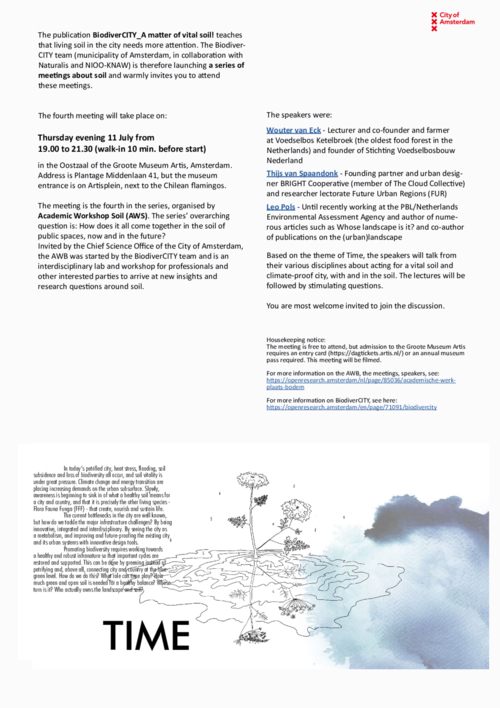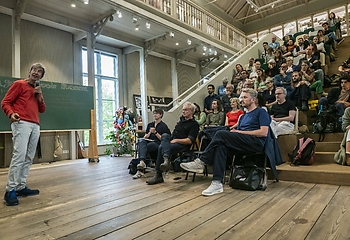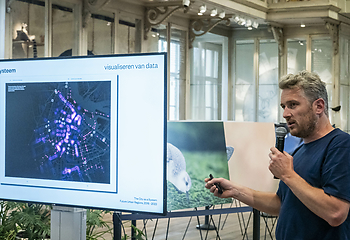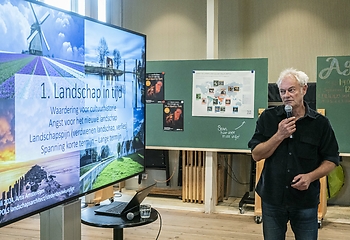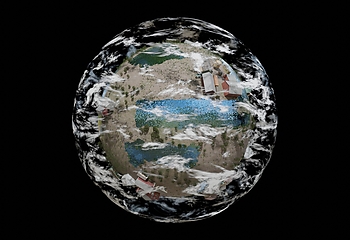The fourth meeting in the AWB series took place on Thursday evening, July 11, in the Oostzaal of the Groote Museum Artis in Amsterdam. The three speakers, each from their own disciplines, spoke on the theme of TIME about soil, about acting for a vital soil and a climate-proof city, in and with the soil.
Wouter van Eck is co-founder and farmer of Voedselbos Ketelbroek near Groesbeek, he started the evening. He began with amazement. He brought a recent comment to our new cabinet under our attention. The comment was: hurry up with those devices to store carbon from the air. But, Van Eck immediately added, a system has already been invented for this, we don't need expensive devices for that! We have green leaves for this, each leaf has stomata on the underside that eat carbon dioxide and the trees store carbon in this way. A significant part of what the leaves make goes into the soil. It's magic, this is how our bare planet once became green! The tone was set, Van Eck continued straight away. We are now in a multiple crisis. The good functions of our soils, biodiversity and carbon storage, must be recovered. Ecological soil cultivation creates healthy soil that captures many greenhouse gases, improves water management, is resilient to extremes and also provides healthy food production and living environment.
In 2009, Van Eck started Voedselbos Ketelbroek, the first food forest in the Netherlands. It was created between cultural-historical parceled landscape. Not every cultural-historical landscape is good for the soil. Much of the agricultural landscape nowadays consists of English ryegrass land, this is a monoculture, which is an ecological disaster, the soil erodes. Ketelbroek is a polyculture, here the soil is not turned, and flora and fauna (and fungi) do their work in terms of soil health.
The Food Forest grew quickly and produced more food every year. The stress and drought year 2018 was overcome with flying colours, while the surrounding farmers had major problems on their land and had to invest a lot of extra money, energy and water to save something of their harvest. Many soils nowadays lack air and water permeability. Heavy machinery literally pushes the air out, this also applies to the city. But on the land everything has really been smoothed out, while higher places in landscapes are desirable for animals and plants (for example, refuges in the event of flooding). If you can and are allowed to combine functions such as nature management, food production, water storage, wood production etc., then (land) systems such as protected nature and agriculture could become better neighbours for each other. Unfortunately, the planning regulations often do not allow this. There are all kinds of separate regulations, departments and subsidy schemes, which actually stimulate fragmentation. In principle, many functions can already be combined on 1 plot, unfortunately it rarely happens. The government advocates extensification of the landscape, but Van Eck advocates intensification of the landscape, multiple functions stacked on top of each other, at the same time. Land that only serves 1 function, that is finished! Then you only cause damage to the soil. Van Eck does not agree with the statement to buy out farmers to create nature. This is a big misunderstanding! We should actually help farmers to produce healthy food. Producing with nature instead of against nature. So become good neighbours to each other.
The restorative capacity of a soil is phenomenal, Van Eck says. If you do not use fertilizers or pesticides and let nature do its work, the soil will recover very quickly and systems will be strengthened again. And do not underestimate the role of fungi. In every teaspoon of soil there are a few hundred meters of fungal thread. Fungi can do things that plant roots cannot, they need each other. For example, fungi extract the water molecules from the pores, holes in the soil. They offer this to plant roots, in return for which they receive sugars. This exchange is not love, but a real barter, a marriage of convenience. Using Scale of Permanence by P.A. Yeoman, Van Eck shows how much time and effort certain things take to change. What is fixed, what can be changed? The slowest is the climate: after 150 years of industrial revolution, it is only now going off the rails. But on the other hand, with greening, tile lifting and ecological farming, the soil can recover in just 3 years. Van Eck concludes with his favorite English word: re-corver. On the one hand, it is re-covering bare landscapes, but also restoring systems.
Wouter van Eck - is a teacher, co-founder and farmer at Voedselbos Ketelbroek (the oldest food forest in the Netherlands). He is also the founder of Stichting Voedselbosbouw Nederland
Thijs van Spaandonk was the second speaker, he is co-founder and urban planner at BRIGHT collective. Together with Eric Frijters of FABRICations and others, they developed two books: Urban Challenges, Resilient Solutions (2014) and The City as a System (2022). In order to better understand the flows in the city (use and life), Frijters had created a diagram that mapped out both top-down goals (legislation and regulations, goals, international market and actors) and bottom-up wishes (local actors and assets, urban trends and personal networks), together with the use (analysis of flows: water, electricity, gas, waste, etc.) and the context (different area conditions). Observing is an important part of this. With the city as a system as a starting point, we need to work and design differently, but how and in what way? New collaborations, typologies and processes were investigated and captured in diagrams. Design research can help, for example, in exploring and discovering coupling opportunities, in managing risks (this is where the lawyers are), in other words: the trade-off between opportunities and risks. Not only a different way of working is needed, but also a new educational program that better connects the two extremes. In this context, it is important to have lawyers think spatially in terms of design and to have designers gain more knowledge of the underlying legal principles in a design. How to deal with uncertainties, regarding time and the restoration of vital soil. Van Spaandonk provided several practical examples. Such as Project Energiek Eerbeek, where a centuries-old paper industry could not expand any further due to many causes. By conducting design research and creating speculative scenarios, it was possible to see what would still be possible for the paper industry in the future, but then in balance with nature and landscape. By finding another energy source (geothermal energy), it is again possible to restore the synergy with the landscape. Another example is the integral story of the City Deal Public Space. How can an integral approach and methodology for the design of underground and above-ground public space be included in design, realization, management and maintenance. The underground in the city is chock-full and more needs to be added. How can we design and manage in an integral way, in process, with the help of data, for organization/culture, finance and legislation and regulations. By scheduling replacement moments of various assets (cables, pipes, wells, locks, trees, etc.) more coordination and the right momentum for the design and management of the soil can be found.
As a final example, Spaandonk shows the Masterplan for the Almere Pampus above and below ground, where a lot of research was done in advance with design research. Almere Pampus is the last part of Almere to be developed, here too a lot of housing construction is to be done. But the area is part of a larger European and national green network. The approach for the masterplan is water and soil-controlling design, looking for a layered (integral) plan. By analyzing landscape lines and areas, dikes, ecological networks, closed water systems, a design could be made for an urban template, with a flexible development program in adaptive grid and distinctive living environments. A lot of data was known about this area (soil types etc.), which can be used well for data-driven designs. For this, the data had to be interpreted, in order to map the layering of the area. Based on this, design principles have been drawn up for the master plan, for the design of the subsurface, for example where good water buffering or housing construction can be realised.
Thijs van Spaandonk - Co-founder and urban planner BRIGHT collective (member of The Cloud Collective) and researcher lectorate Future Urban Regions (FUR). Bright does research and development at the intersection of architecture, urbanism, sociology, for creating brighter futures.
Leo Pols was the last in the line of inspiring speakers to speak. He is a landscape architect and urban planner by training and worked for the Netherlands Environmental Assessment Agency for a long time. To start, he showed a series of geological maps of the Netherlands, from 9000 BC (Holocene) to 2000 AD (Anthropocene), with a visionary glimpse of the future landscape around 2200. The development of peat areas throughout the Netherlands around the beginning of the Common Era was striking, which slowly disappeared again due to the exploitation of the land for habitation and agriculture. Pols stated: there has always been a fear of new landscape, many people are afraid of change. Or the other way around, people can also stubbornly continue to act incorrectly, such as building in land that is too low. He cited the Zuidplaspolder as an example, where construction is in full swing while the polder is 6 metres below NAP. It has been raised by one metre to build on, but if a storm surge occurs (+4 NAP), people will not be safe in their attics. And yet they keep on building. To provide more insight into ownership and management of landscape, Pols took the audience along to see who actually owns the landscape. A coloured map of the Netherlands showed the various landowners that outside the city the landscape is for farmers and businesses (together 71%), in the city fringes the landscape is mainly in the hands of government and private individuals and that in the city the landscape is mainly in the hands of the government. The map also shows that municipalities own a lot of land in the city fringes, where there are also considerable opportunities for greening to restore soil functions.
Unfortunately, Pols also noted that water and soil in the Netherlands are poorly managed by landowners. For example, the quality of the soil of the land of nature organizations is influenced by owners from outside their territory. Four major soil threats can be noted: 1_Nitrogen deposition (agriculture, shipping and aviation, construction sector), 2_ Soil subsidence (CO2, water management, safety), 3_ Desiccation and drop in groundwater level (nature, agriculture) and 4_ Salinization (agriculture). The soil and water management in the Netherlands is in a bad state, 98% does not comply with the Water Framework Directive (WFD - established to improve the quality of surface and groundwater in Europe), in other words: the Netherlands is the worst in the EU class! In addition to the four threats, there are other dangers: creeping urbanization and industrialization of agricultural companies, which puts 'our' landscape under even more pressure. Where it was once the land of many, the land is now increasingly privately owned! In the 19th century, there were still many ‘wastelands’ owned by the state. In the 21st century, more and more farms own more land per farm. In other words, fewer and fewer people own more land, and as a result, farmers are becoming more powerful, who also start developing. As a result, land ownership shifts from farmers to companies and investors. Conclusion: less than 25% of the landscape and cities in the Netherlands is owned by governments and nature organisations. This is higher in the urban fringes, where 44% is owned by governments and nature managers. Land ownership is of crucial importance in area development. Steering towards this can be decisive! The best opportunities lie in the urban fringes – the links between city and countryside! As the last part of the lecture, he guides the visitor through four future scenarios for the development of the Netherlands in 2050. With these scenarios, he and colleagues from PBL travelled across the country to have discussions and hold workshops with all kinds of governments, institutions and services. The four scenarios were developed to look further ahead and to think more deeply about what can and should be done for a future-oriented landscape. Pols immediately notes that the four scenarios do not represent a vision, but offer possible perspectives to investigate several issues, such as: setting points on the horizon because transitions take decades and therefore multiple cabinet periods. The four scenarios provided insights into the role of the government per scenario, whether or not there was cooperation between nature and agriculture, and what is put forward as a priority, Profit or Planet first?
The conclusions of the four scenarios taught the team what is future-proof/robust policy? Learning to deal with uncertainties, both in the tasks (climate, demography, economic growth), as well as how to realize them (society, politics). But above all, focus on robust and flexible measures for a nature-inclusive city, where multiple use of space and a water and soil system become leading. In addition, use the nitrogen dossier to connect and also think carefully about new concepts for multiple land use.
Leo Pols - Until recently employed at the Netherlands Environmental Assessment Agency and author of numerous articles such as Who owns the landscape? and co-author of studies Four scenarios for the development of the Netherlands in 2050 and Towards a more broadly supported nature policy in the Netherlands
